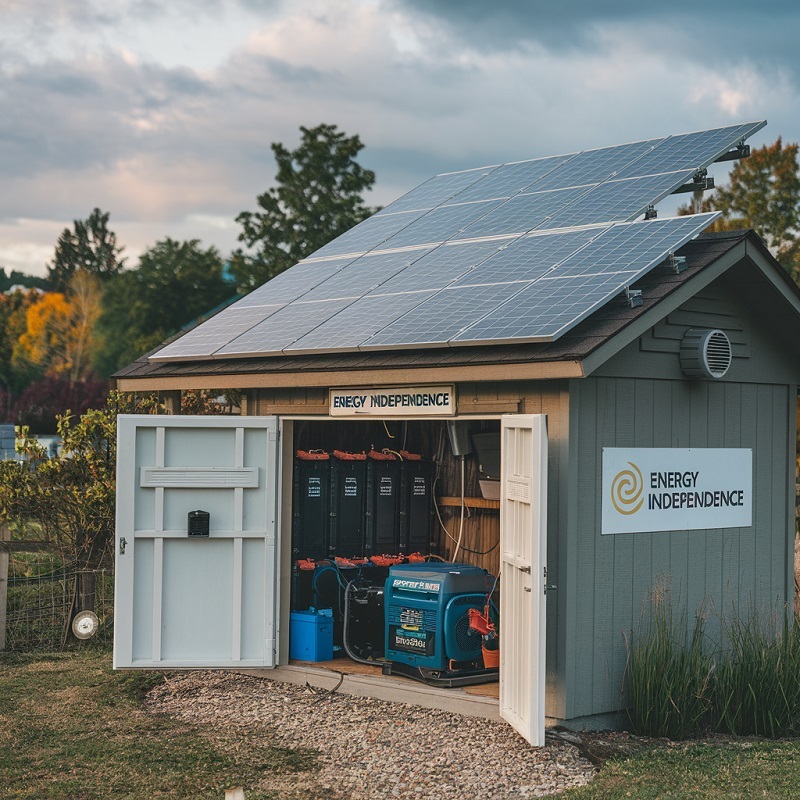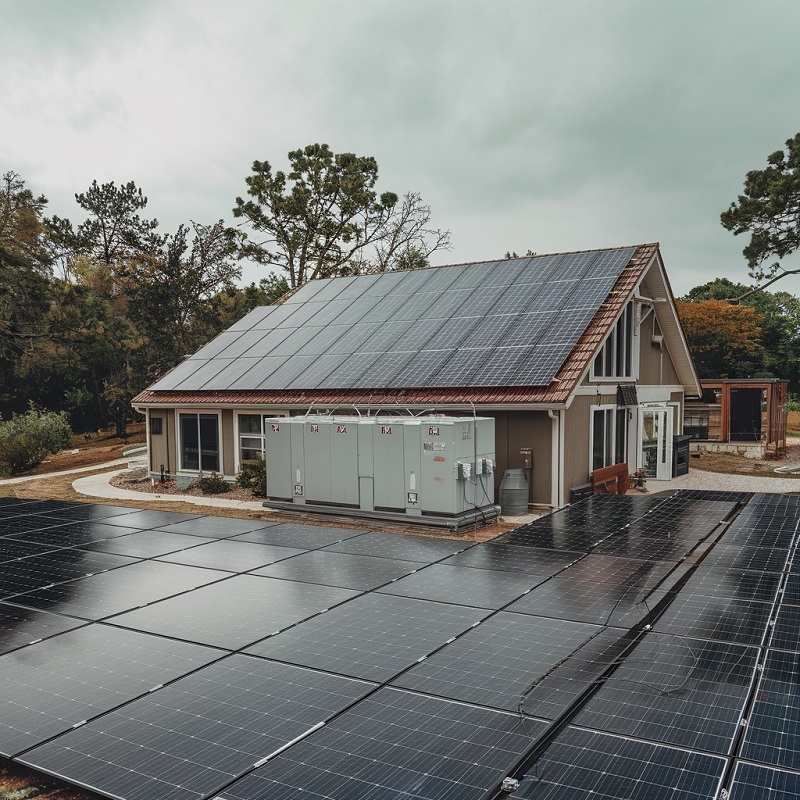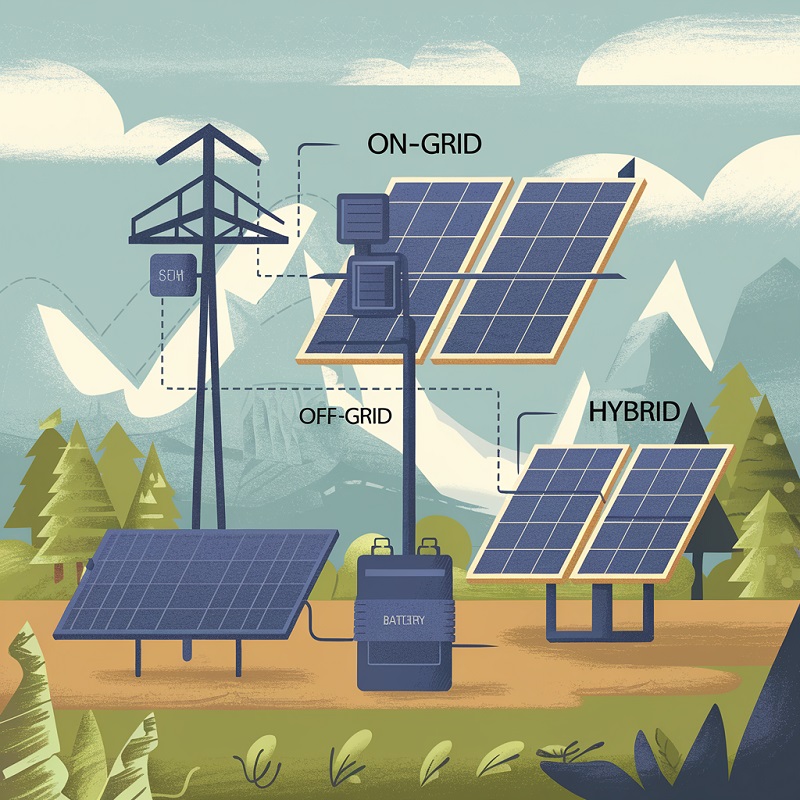As the world shifts toward renewable energy, “off grid solar system” are becoming a popular choice for individuals seeking energy independence and sustainability. This comprehensive guide breaks down the basics, technology, benefits, and drawbacks of off-grid solar, helping you determine if it’s the right solution for you.
Key Takeaways
- Off grid solar system provides complete energy independence, ideal for remote areas or those wanting to disconnect from the grid.
- They rely heavily on batteries to store power, especially for use at night or during cloudy weather.
- While on-grid systems are cheaper and more common in urban areas, off-grid and hybrid systems offer resilience and independence.
- Properly sizing your system and batteries is key to ensuring reliable power.

What Is an Off Grid Solar System?
An off grid solar system is a self-sufficient power setup that does not rely on the public electricity grid. These systems generate energy directly from solar panels, store it in batteries, and supply power to a property or location without any connection to traditional utility services. Perfect for remote areas or those looking to reduce reliance on conventional energy sources, an off-grid system can power homes, cabins, RVs, or even small businesses.
Key Components:
1. Solar Panels: Capturing the Sun’s Energy
Solar panels are the heart of any solar system, converting sunlight into electricity through photovoltaic (PV) cells. These come in different types (monocrystalline, polycrystalline, and thin-film), each with its own efficiency, cost, and durability characteristics.
How to Choose Solar Panels:
- Efficiency: Monocrystalline panels have the highest efficiency (up to 22%) and are ideal for small spaces. Polycrystalline panels are less efficient (15-17%) but more affordable. Thin-film panels are lightweight and flexible, but their efficiency is the lowest (~10-12%).
- Wattage: Solar panels are rated in watts (W), typically between 250W to 400W per panel. A system for a small home might need 10-15 panels of 300W each, while a larger home could require 20 or more panels.
- Durability: Most panels come with a 25-30 year performance warranty, ensuring long-term reliability. Look for panels with a high-quality aluminum frame and tempered glass to withstand harsh weather conditions (e.g., hail, snow, and strong winds).
- Temperature Coefficient: Solar panels perform better in cooler conditions. The lower the temperature coefficient, the better they will perform under high heat.
Tips:
For regions with limited roof space or aesthetic concerns, consider building-integrated PV (BIPV) panels. These replace standard roofing materials and blend seamlessly into the architecture, functioning as both a roof and an energy generator.
2. Charge Controller: Safeguarding Battery Health
The charge controller regulates the flow of electricity from the solar panels to the battery bank, ensuring that the batteries are not overcharged or damaged. There are two types: Pulse Width Modulation (PWM) and Maximum Power Point Tracking (MPPT).
How to Choose a Charge Controller:
- Type: MPPT controllers are more efficient than PWM (up to 30% more efficient), especially in systems with higher voltage solar arrays or in regions with variable sunlight.
- Current Rating: The size of the charge controller depends on the size of your solar array. For instance, a 1000W solar array with a 12V system would require a controller that can handle around 83A (1000W ÷ 12V = 83A). Always choose a controller with at least 25% more capacity than your system to accommodate surges or system expansion.
- Durability: Look for controllers with heat dissipation features (e.g., aluminum casing and cooling fans) to prevent overheating, and make sure they are waterproof or weatherproof for outdoor setups.
Tips:
Some charge controllers come with built-in monitoring systems or Bluetooth connectivity. This allows you to track energy production and battery health directly from your smartphone, giving you real-time insights into system performance.
3. Battery Bank: Storing Energy for Later Use
The battery bank stores excess energy generated by the solar panels for use when the sun isn’t shining, such as at night or during cloudy weather. Batteries are typically the most expensive component of an off-grid solar system but are crucial for energy independence.
How to Choose a Battery Bank:
- Type: The two most common types of batteries are Lead-Acid (flooded or sealed) and Lithium-Ion. Lead-acid batteries are cheaper but require regular maintenance and have a shorter lifespan (5-7 years). Lithium-ion batteries are more expensive upfront but last longer (10-15 years), require little to no maintenance, and offer better efficiency.
- Capacity (Ah): Battery capacity is measured in amp-hours (Ah). To determine how much capacity you need, calculate your daily energy usage and multiply it by the number of days you want the battery to last without sunlight. For example, if your home uses 10kWh per day and you want 2 days of backup, you would need around 833Ah at 24V (10,000W ÷ 24V = 417Ah x 2 = 833Ah).
- Voltage (V): Most systems use 12V, 24V, or 48V batteries. Higher voltage systems are more efficient and allow for smaller wiring sizes, but lower voltage systems are easier to expand.
- Durability: Look for batteries with depth of discharge (DoD) of 80% or higher, as this indicates how much of the battery’s capacity can be used without damaging it.
Tips:
Consider modular battery systems like the Tesla Powerwall or LG Chem RESU. These systems can be stacked to increase capacity as your energy needs grow, providing flexibility for future expansion.
4. Inverter: Converting DC to AC Power
An inverter converts the DC electricity stored in batteries or generated by solar panels into AC power, which most household appliances use. In off-grid systems, inverters are critical for providing the type of electricity that powers your home.
How to Choose an Inverter:
- Size (Wattage): The inverter should be sized based on your peak power demand. For example, if you have appliances that together consume 5000W at peak times (e.g., running the refrigerator, TV, and lights simultaneously), you’ll need an inverter rated for at least 5000W. It’s a good idea to oversize slightly (e.g., a 6000W inverter for a 5000W load).
- Type: There are two main types of inverters: Pure Sine Wave and Modified Sine Wave. Pure sine wave inverters are more expensive but provide cleaner power, essential for sensitive electronics like computers or LED lighting. Modified sine wave inverters are cheaper but may cause issues with some appliances.
- Durability: Choose inverters with heat protection features (cooling fans or heat sinks) and those that offer overload protection to prevent damage during surges in power demand.
Tips:
Some inverters come with built-in chargers that allow you to charge your battery bank from an external source (e.g., a generator or the grid). This is particularly useful in hybrid systems or for off-grid setups that need a backup option during extended periods without sunlight.
5. Backup Generator: A Safety Net for Energy
A backup generator provides extra energy when solar power and battery storage are insufficient, such as during long stretches of cloudy weather or higher-than-usual energy consumption. It’s an optional component but a practical one for off-grid systems.
How to Choose a Backup Generator:
- Size: Your generator should be able to supply enough power to meet your critical needs during periods of low solar output. For example, if your peak load is 5000W, you’ll want a generator that can handle at least 5000-6000W.
- Fuel Type: Generators typically run on gasoline, propane, or diesel. Propane and diesel are more fuel-efficient and produce less carbon, making them better long-term choices for off-grid living.
- Automatic Start: Some generators can be set to automatically start when the battery charge gets too low, providing seamless power without manual intervention.
Tips:
Consider installing a dual-fuel generator that can run on both propane and gasoline. This adds flexibility, allowing you to switch between fuels based on availability and cost.

Additional Tips for System Sizing and Durability
- Location and Climate: The amount of sunlight you receive daily will impact the size of your solar array and battery bank. For example, if you live in a location with only 4 peak sunlight hours per day, you’ll need more solar panels than someone living in an area with 6-8 peak hours.
- Energy Efficiency: The more energy-efficient your appliances and home, the smaller (and cheaper) your off-grid system can be. Switching to LED lighting, energy-efficient appliances, and better insulation can drastically reduce your energy needs.
- Monitoring Systems: Many modern solar systems come with remote monitoring apps, allowing you to track energy production, consumption, and battery health in real-time. This helps ensure your system is running at peak efficiency and alerts you to any potential issues before they become major problems.
With these considerations in mind, you can tailor your off-grid solar system to your specific needs, ensuring it is both efficient and durable for long-term use.
How Off Grid Solar Works
Off grid solar systems operate independently from the traditional electricity grid, relying on solar energy stored in batteries. The energy generated during daylight hours is stored and then used as needed. This system is especially useful in locations with no access to utility power, ensuring you remain powered up even in remote areas.
Step-by-Step Process:
- Sunlight Hits the Solar Panels: Solar panels capture sunlight and convert it into DC electricity.
- Charge Controller Manages Power Flow: The charge controller regulates the flow of energy into the battery bank.
- Energy Stored in Batteries: Excess energy generated during the day is stored in batteries for use at night or during cloudy weather.
- Inverter Converts DC to AC Power: The stored DC energy is converted into AC electricity to power your home or appliances.
- Backup Power Source: If battery storage is depleted, a backup generator or alternative source can kick in.
Advantages of Off-Grid Solar Systems
Choosing an off-grid solar system offers several advantages, especially for individuals seeking energy independence. Here are some of the key benefits:
Benefits:
- Energy Independence: Complete freedom from reliance on utility companies.
- Sustainability: Off-grid systems rely entirely on renewable solar energy, making them eco-friendly.
- Ideal for Remote Locations: Great for areas with no access to traditional power grids.
- Resilience: Protection from blackouts, energy price hikes, and other grid-related issues.
Challenges:
- Higher Initial Costs: Requires significant upfront investment in equipment and installation.
- Maintenance: Batteries require regular maintenance and may need replacement over time.
- Energy Management: Careful monitoring of energy usage is necessary to avoid depleting stored power.
On-Grid vs. Off-Grid vs. Hybrid Solar Systems
When choosing a solar system, it’s important to understand the different types available.
On-Grid Solar Systems
On-grid solar systems, also known as grid-tied systems, are connected to the public electricity grid. They generate power from solar panels, and any excess electricity produced can be fed back into the grid, often allowing homeowners to receive credits or reduce their electricity bills. This system doesn’t require batteries since the grid serves as a backup power source. However, on-grid systems won’t function during a power outage unless they are paired with an optional battery storage system. These are ideal for homes and businesses located in areas with reliable grid access.
Off-Grid Solar Systems
An off-grid solar system operates independently of the electricity grid, providing complete self-sufficiency. It relies on solar panels to generate electricity and uses batteries to store excess energy for use during cloudy days or at night. Since the system isn’t connected to the grid, a backup generator may also be included to ensure power during extended periods of bad weather. Off-grid systems are commonly used in remote locations where grid access is not available, but they come with higher upfront costs due to the need for battery storage and backup solutions.
Hybrid Solar Systems
Hybrid solar systems combine the best of both on-grid and off-grid systems. These systems are connected to the grid but also incorporate battery storage, allowing homeowners to store excess energy for later use while still having access to the grid as a backup. During a grid outage, a hybrid system can continue to supply power from the battery storage. Hybrid systems offer greater flexibility by reducing reliance on the grid while still providing the convenience of grid connectivity. They are ideal for areas with unreliable grids or for users seeking energy resilience without going completely off-grid.
Here’s a comparison of on-grid, off-grid, and hybrid systems:
| Feature | On-Grid Solar | Off-Grid Solar | Hybrid Solar |
| Connection to Grid | Yes | No | Yes |
| Battery Storage | Optional | Yes | Yes |
| Energy Backup | Grid acts as backup | Battery or generator | Battery, grid, or generator |
| Cost | Lower upfront costs | Higher due to batteries | Moderate-high cost |
| Power During Outages | No | Yes | Yes |
| Best for | Urban areas with grid access | Remote or off-grid areas | Areas with unreliable grids |
How Many Solar Watts Do You Need for an Off-Grid System?
The amount of solar power required depends on your energy consumption, location, and the size of the system. Here’s a general guide for estimating:
- Small Homes or Cabins: 3-5 kW (3000-5000 watts)
- Medium Homes: 5-10 kW (5000-10,000 watts)
- Large Homes: 10-15 kW (10,000-15,000 watts)
- RVs or Tiny Homes: 1-3 kW (1000-3000 watts)
To calculate your specific needs, assess your total energy consumption (kWh per month) and the average peak sunlight hours in your location. Most solar companies provide online calculators to help estimate system size.
Can You Run an Off-Grid Solar System Without a Battery?
Technically, you can run some off-grid solar systems without batteries, but it’s not ideal. Batteries play a crucial role in storing energy for times when sunlight is unavailable, such as at night or during cloudy days.
When Batteries Are Not Used:
- Power is only available when the sun is shining, so no electricity at night or during overcast weather.
- For optimal functionality, batteries are recommended to ensure consistent power supply.
How Long Do Off-Grid Solar Systems Last?
Most off-grid solar systems can last anywhere from 20-30 years, depending on maintenance and component quality.
- Solar Panels: 25-30 years lifespan.
- Inverter: 10-15 years before replacement.
- Batteries: 5-15 years, depending on type (e.g., lead-acid vs. lithium-ion).
- Charge Controller: 10-15 years.
Regular maintenance and monitoring can help extend the life of these components and ensure system efficiency.
How Many Batteries Do You Need for an Off-Grid Solar System?
The number of batteries required for an off-grid solar system depends on your energy consumption and desired backup capacity. Here’s a basic guide:
| Energy Usage (kWh/day) | Battery Capacity Needed (Ah) | Example Battery Setup |
| 5 kWh/day | 417 Ah (24V system) | 4 x 100Ah batteries |
| 10 kWh/day | 833 Ah (24V system) | 8 x 100Ah batteries |
| 20 kWh/day | 1667 Ah (48V system) | 8 x 200Ah batteries |
Battery sizing is crucial for ensuring you have enough stored energy to cover cloudy days or nighttime usage.
FAQs on Off-Grid Solar Systems
- Which is better, on-grid or off-grid solar?
It depends on your needs. On-grid systems are more affordable and practical in areas with reliable grids, while off-grid systems offer independence but come with higher upfront costs. If you want backup and flexibility, a hybrid system may be the best of both worlds.
- What is the drawback of off-grid solar systems?
The biggest drawbacks are the initial costs and maintenance. Off-grid systems require batteries, which increase both upfront costs and ongoing maintenance. Additionally, you need to carefully monitor energy usage and storage to ensure power availability.
- How many solar watts do you need for an off-grid system?
You’ll typically need 3-10 kW, depending on your energy consumption. For larger homes or higher energy use, 10-15 kW systems may be necessary.
- Can we run off-grid solar systems without a battery?
It’s technically possible, but without a battery, you’ll only have power when the sun is shining. Batteries store energy for night use or cloudy days, making them essential for most off-grid systems.
- What is the difference between off-grid and hybrid solar systems?
The main difference is that hybrid systems are connected to the grid and have battery storage, offering more flexibility. Off-grid systems operate entirely independently from the grid, relying solely on solar and battery storage.
- How long does an off-grid solar system last?
Off-grid systems typically last 20-30 years, but individual components like batteries may need replacement every 5-15 years.
- How many batteries do you need for an off-grid solar system?
The number of batteries depends on your energy consumption. A small home might need 4-6 batteries, while larger systems could require 8 or more.
Off-grid solar is a fantastic option for those ready to embrace renewable energy and live independently. The initial investment is higher, but the long-term benefits of sustainable, grid-free energy are substantial.





